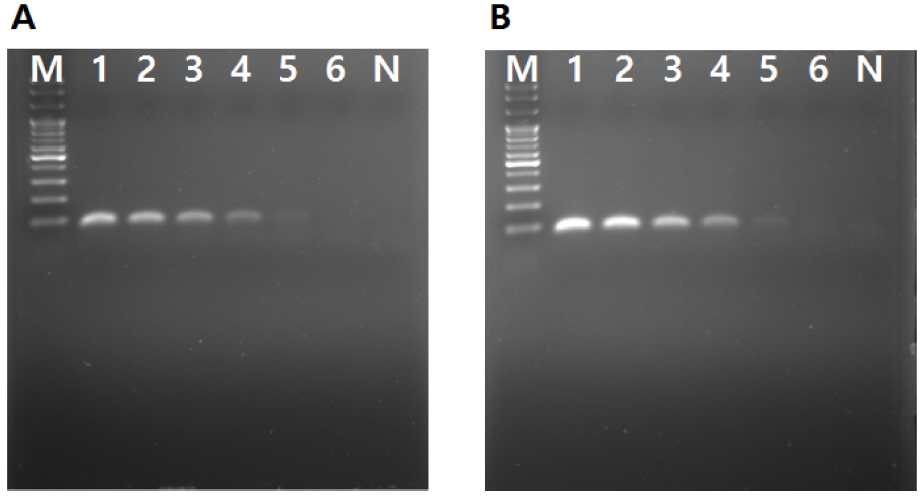
Strobilurin계 살균제 Pyraclostrobin에 대한 고추탄저병균 Colletotrichum acutatum의 저항성 발현 및 기작
초록
2004년부터 2015년까지 단포자 분리를 통하여 확보한 고추탄저병균인 Colletotrichum acutatum 227개 균주를 사용하여, strobilurin계 살균제인 pyraclostrobin에 대한 감수성 변화를 조사하였다. Pyraclostrobin에 대한 감수성 변화는 PDA에서 한천희석법으로 수행하였다. 2014년까지 분리한 탄저병균의 평균 EC50값은 0.16 μg/mL 이하였으며, 저항성 요인값도 2006년에만 157로 높게 나타났고, 나머지 연도에 분리한 탄저병균 집단은 20 이하로 낮았다. 하지만 2015년 탄저병균 집단의 평균 EC50값은 16.437 μg/mL이었고, 저항성 요인값도 40,000 이상이었다. 결국 국내 고추탄저병균도 2015년에 청양, 공주, 부여, 익산 등에서 채집한 병원균에서부터 strobilurin계 살균제에 대해서 저항성이 발생하였음을 확인하였다. 한천희석법으로 pyraclostrobin의 탄저병균에 대한 균사생장 억제효과를 조사할 때 대체호흡 억제제인 SHAM의 첨가 효과를 조사하였으나, SHAM의 첨가가 균사생장 억제효과에는 영향이 없었다. Pyraclostrobin 감수성과 저항성인 C. acutatum의 cyt b 유전자의 염기서열을 분석한 결과, 143번째 아미노산이 glycine에서 alanine으로 치환되어 있었다. 이 치환부위를 이용하여 대립유전자 특이적인 primer 를 제작하고 유전자를 증폭한 결과, 감수성과 저항성 C. acutatum에서 각각 특이적으로 유전자가 증폭하는 것을 확인하였다. 본 논문의 결과에서 보는 것과 같이, 국내 고추탄저병균도 pyraclostrobin에 대한 저항성이 발생하였고, cyt b 유전자의 점돌연변이가 살균제 저항성 발생의 원인이라고 생각한다. 이 변이 부위를 이용한 대립유전자 특이적인 primer를 제작하였고, 대립유전자 특이적인 PCR을 통하여 신속하고 정확하게 저항성균을 검정할 수 있었다.
Abstract
Changes in the sensitivity to pyraclostrobin, a strobilurin fungicide, were investigated by using 227 isolates of Colletotrichum acutatum causing pepper anthracnose, which were obtained from infected pepper fruits from 2004 to 2015 through a single spore isolation. The detection of the sensitivity of all isolates to pyraclostrobin was performed by an agar dilution method on PDA with or without the fungicide. The mean EC50 values of the isolates obtained until 2014 was no more than 0.16 μg/mL. The resistance factor value was high at 157 in 2006 alone, and the population of C. acutatum isolated in the rest of the year was below 20. In 2015, however, the mean EC50 value of the isolate group was 16.437 μg/mL and the resistance factor value was over 40,000. It was confirmed that isolates of C. acutatum, collected in Cheongyang, Gongju, Buyeo, and Iksan in 2015, were resistant to pyraclostrobin. It was investigated whether the effect of fungicide increased by adding SHAM, an alternative respiratory inhibitor, to the medium, when investigating the inhibitory effect of pyraclostrobin on the mycelial growth of C. acutatum by using an agar dilution method. However, addition of SHAM did not affect the inhibitory effect of the fungicide on the mycelial growth of C. acutatum. Analysis of the nucleotide sequences of the cytochrome b (cyt b) gene of C. acutatum isolates, which is sensitive and resistant to pyraclostrobin, revealed that the 143th amino acid was substituted for alanine in glycine. An allele-specific primer was prepared using this substitution site, and the primer was used to amplify the part of cyt b gene. Just as amplification products were formed only in susceptible isolates in PCR using sensitive primers, only products of resistant isolates were amplified in PCR using resistant primers. In Korea, as shown in the results of this paper, isolates of C. acutatum resistant to pyraclostrobin was found only among isolates obtained in 2105. The resistance of C. acutatum to pyraclostrobin appears to be related to point mutations in the cyt b gene. If allele-specitic PCR is performed using an allele-specific primer prepared using this mutation site, it will be able to detect C. acutatum resistant to pyraclostrobin quickly and accurately.
Keywords:
Colletotrichum acutatum, fungicide resistance, pepper anthracnose, pyraclostrobin키워드:
Colletotrichum acutatum, 살균제 저항성, 고추탄저병균, pyraclostrobin서 론
Strobilurin계 살균제는 2000년에 개발되어 2002년부터 상품화되었으며, 2016년 미국의 주요 작물에서 3번째에 위치할 정도로 사용량이 많은 살균제로 자리매김하였다(Bartlett et al, 2002; Pillips, 2018). 국내에서도 중요한 조미채소 중에 하나인 고추의 탄저병 방제에 대한 효과가 우수하기 때문에 고추 재배 현장에서 많이 사용하는 살균제 중에 하나이다(Oo and Oh, 2016; Saxena et al. 2016). 특히 고추 탄저병 방제를 위한 살균제 처리 체계를 만들면서 탄저병이 발생하기 직전과 직후에 꼭 처리해야하는 살균제로 pyraclostrobin과 동일한 strobilurin계 살균제가 제안되고 있다.
만약 이 시기에 strobilurin계 살균제의 처리가 제외된다면 처리 체계의 효과는 감소하게 될 정도로, 고추 탄저병 방제에 있어서 strobilurin계 살균제의 중요성은 매우 크다. 하지만 최근 고추 재배 포장에서 strobilurin계 살균제의 탄저병 방제 효과가 저하되는 현상들이 나타나면서 살균제 저항성 발생 여부를 확인해야하는 문제가 발생하였다.
Strobilurin계 살균제의 작용기작은 미토콘드리아 내막에 있는 cytochrome bc1 효소 복합체의 기능을 억제하여 전자의 이동을 방해함으로써 ATP의 합성을 억제하는 것으로 알려져 있다(Bartlett et al., 2002). 하지만 그 작용점이 매우 특이하기 때문에 포장에서 반복적으로 사용할 경우 저항성균의 출현이 매우 용이한 살균제이기도 하다. Strobilurin계 살균제에 대한 포장 저항성균의 발생은 1998년 독일 북부의 밀 재배 지역에서 흰가루병을 일으키는 Blumeria graminis f. sp. tritici에서 최초로 보고되었다(Heaney et al., 2000). 그 후 흰가루병균(Sierotzki et al., 2000; Ishii et al., 2001; Kim et al., 2008), 노균병균(Ishii et al., 2001; Collina et al., 2005), Alternaria spp.(Ma et al., 2003). Pyricularia grisea(Kim et al., 2003), Venturia sp. (Steinfeld et al., 2001) 등 다양한 식물병원균에서 발생이 계속적으로 보고되어, 식물병원균의 저항성 발현 여부를 검정할 필요성이 높아졌다. Strobilurin계 살균제에 대한 저항성 발생 여부를 검정하는 방법으로는 전통적인 한천희석법과 살균제 저항성 유전자를 사용하는 분자 검정 방법이 있다(Ma and Michailides, 2005). 한천희석방법은 병든 식물체로부터 분리한 병원균을 살균제를 첨가하지 않은 배지와 살균제를 첨가한 배지에서 각각 배양하고 생장 정도를 측정하여 비교함으로써 저항성의 여부를 결정한다. 그러다보니 여러 지역에서 다량의 균주를 확보하여 검정을 수행하여야 하며, 이는 많은 노력과 시간을 필요로 한다. 하지만 저항성 분자 마커를 찾을 수 있다면 짧은 시간에 신속하고 정확하게 살균제에 대한 저항성 발생 여부를 검정할 수 있다.
Strobilurin계 살균제의 저항성 기작은 살균제의 작용점인 미토콘드리아의 cytochrome b (cyt b) 유전자에서 발생하는 점돌연변이가 원인으로 알려져 있는데, 129번째와 143번째의 아미노산이 phenylalanine이 leucine으로, glycine이 alanine으로 치환되면서 효소 활성에는 아무런 영향을 미치지 않으면서 살균제에 대한 병원균의 감수성이 저하한다. 특히 143번째 아미노산의 치환은 많은 식물병원균에서 보고되어 있다(Sierotzki et al., 2000; Ishii et al., 2001; Baumler et al., 2003; Kim et al., 2003; Ma and Michailides, 2003).
국내에서도 고추 탄저병 방제를 위해서 오래 전부터 strobilurin계 살균제를 사용하고 있지만, 고추탄저병균이 살균제에 대해서 저항성이 발현됐는지의 여부를 검정한 적은 없다. 본 연구에서는 strobilurin계 살균제 중 하나인 pyraclostrobin을 선발하여 고추 탄저병균의 저항성 발현 여부를 한천희석법으로 조사하였다. 또한 strobilurin계 살균제의 작용점인 cyt b 유전자를 증폭하여 저항성균과 감수성균의 염기서열을 분석하고, 염기서열 차이를 이용하여 간편하고 정확한 저항성 검정 방법을 확립하고자 하였다.
재료 및 방법
병원균 채집 및 보관
전국의 고추 포장에서 탄저병의 병징을 보이는 열매를 채집하여 단포자를 분리하였다. 화염 멸균한 백금이를 이용하여 채집한 고추 탄저병의 병징 부위에서 분생포자를 떼어 멸균증류수(300 μg/mL의 streptomycin 첨가)에 넣고 고르게 섞어 포자 현탁액을 만들었다. 포자 현탁액의 포자 밀도는 1 × 104 spores/mL로 조절한 후 50 μL를 300 μg/mL의 streptomycin이 첨가된 PDA 배지(potato dextrose agar; Becton, Dickinson and Company, DifcoTM)에 도말한 후 25oC 배양기에서 2일간 배양하였다. 배지에 형성된 단균총을 분리하는 방법으로 병원균의 단포자를 분리하였다. 분리한 균주들은 PDA 배지에 옮겨서 25oC 배양기에서 10일간 배양하였다. CryotubeTM vial (직경 12 mm, 높이 48 mm, Nunc Co. Ltd)에 300 μg/mL의 streptomycin이 첨가된 멸균증류수를 1.5 mL 넣은 후 배양한 균총의 균사 선단부에서 지름 5 mm의 균사 조각을 떼어내어 10조각 이상씩 넣고 상온에서 보관하였다. 또한 장기간 보관을 위해서 5% DMSO (dimethyl sulfoxide)가 첨가된 멸균증류수를 사용하여 -70oC 초저온냉장고에서 보관하였다.
실험에 사용한 병원균과 살균제
실험에 사용한 C. acutatum 중 일부는 2004년부터 2010년까지 고추 열매에서 단포자를 분리하여 충북대학교 농업생명환경대학 식물진균병학실험실에서 보관하고 있는 고추탄저병균과, 2014년과 2015년에 고추 열매의 병반에서 다시 단포자 분리한 균주 등을 합하여 총 227개의 균주를 본 실험에 사용하였다. 고추탄저병균에 대한 살균제 반응을 조사하기 위하여 strobilurin계 살균제에 속하는 pyraclostrobin(a.i. 11%, SC)을 본 실험에 사용하였다.
한천희석법을 이용한 병원균의 살균제 감수성 조사
Pyraclostrobin에 대한 C. acutatum의 감수성 조사를 위해 한천희석법을 통한 균사생장 억제율을 조사하였다. 살균제는 멸균증류수에 녹여 사용하였고, 살균제의 농도는 10, 2, 0.4, 0.08, 0.016, 0 μg/mL로 조정하였다. 또한 배지 상에서 병원균의 대체 호흡 경로를 통한 호흡을 억제하기 위하여 salicylhydroxamic acid (SHAM; SIGMA-ALDRICH, Lot # STBD3487V, 99%, MW; 153.14)을 DMSO에 용해하여 최종 농도가 100 μg/mL이 되도록 첨가하였는데, DMSO의 최종 농도도 1% 이하가 되도록 조정하여 배지에 첨가하였다. PDA 배지 상에서 7일간 배양한 병원균의 균사 선단에서 직경 3 mm의 조각을 떼어 각 살균제가 농도별로 첨가된 PDA 배지에 접종하였다. 병원균을 접종한 배지는 25oC 암조건 배양기에서 5~7일간 배양한 후, 살균제를 첨가하지 않은 배지에서 균총의 직경이 35~40 mm가 되었을 때 조사하였다. 실험한 살균제의 균사생장 억제율(%)은 아래 식에 의해서 계산하였다.
병원균의 cyt b 유전자 증폭 및 염기서열 분석
C. acutatum의 cyt b 유전자의 증폭을 위하여 Cacytb-P2(5'-CAT AGT AAY ACA GCT TCT G-3')와 Cacytb-R(5'-GGA ATA GAT CTT AAT ATA GC-3') primer를 사용하였다. PCR 반응액은 희석된 gDNA 0.1 μg에 10X KAPA Taq buffer with dye 2.5 μL, dNTP (각 2 mM) 2.5 μL, 10 pmole의 Cacytb-P2, Cacytb-R primer를 각각 1 μL, Taq polymerase(5 units/μL, Kapabiosystems) 0.1 μL, 멸균증류수 15.9 μL를 첨가하여 만들었다. 반응조건은 3분간 94oC에서 pre-denaturation 수행 후, 40초 동안 94oC에서 denaturation, 40초 동안 37oC에서 annealing, 1분 30초 동안 72oC에서 extension을 35회 반복하였고, 72oC에서 5분 동안 반응 시킨 후 종료하였다. 여기에서 얻어진 PCR 산물들을 확인하기 위하여 1X TAE buffer로 1% agarose gel을 만들고 safe viewTM classic을 권장 사용량에 맞춰 첨가하였다. 100 V, 35분간 전기영동 한 후 UV-transilluminator를 사용하여 증폭산물을 확인하였다. 증폭이 확인된 시료들은 ExpinTM PCR SV kit (GeneAll, Seoul, korea)를 사용하여 정제한 후 Macrogen (Daejeon, Korea)에 염기서열 분석을 의뢰하였다. 분석된 cyt b 유전자의 염기서열은 BioEdit ver. 7.0.9.0의 clustal X를 이용하여 정리하였고, MEGA ver. 5.2.1에서 정렬한 후 NCBI GenBank의 염기서열을 획득하여 유연관계를 확인하였다.
Allele-specific PCR
살균제 저항성인 C. acutatum의 cyt b 유전자의 아미노산 치환부위를 가지고 저항성 균주와 감수성 균주를 신속 정확하게 검출하기 위한 allele-specific primer를 제작하였다(Table 1). 저항성 균주들의 치환부위인 cyt b 유전자의 428번째 염기가 reverse primer 3′ 말단 끝에 위치하도록 제작하였고, 저항성 균주와 감수성 균주를 정확하게 검출하기 위해서 미스매치 방법을 활용하여, 저항성 특이적 primer의 3′ 말단은 CG로 끝나게 하고, 감수성 특이적 primer의 3′ 말단은 CC로 끝나도록 제작하였다. PCR 반응액은 희석된 gDNA 0.1 μg에 10X KAPA Taq buffer with dye 2.5 μL, dNTP (각 2 mM) 2.5 μL, 10 pmole의 forward primer와 reverse primer를 각각 1 μL, Taq polymerase (5 units/μL, Kapabiosystems) 0.1 μL, 멸균증류수 15.9 μL를 첨가하여 만들었다. 반응조건은 4분간 95oC에서 pre-denaturation을 수행 후, 30초 동안 94oC에서 denaturation, 30초 동안 58oC에서 annealing, 1분 20초 동안 72oC에서 extension을 30회 반복하였고, 72oC에서 5분 동안 반응 시킨 후 종료하였다. 여기에서 얻어진 PCR 산물들을 확인하기 위하여 0.5X TBE buffer로 1.5% agarose gel을 만들고 safe viewTM classic을 권장 사용량에 맞춰 첨가하였다. 100 V, 40분간 전기영동 한 후 UV-transilluminator를 사용하여 증폭산물을 확인하였다.
결과 및 고찰
병원균의 분리 및 동정
고추 열매에서 단포자 분리한 탄저병균 중에서 2004년 15균주, 2006년 18균주, 2007년 23균주, 2008년 12균주, 2009년 17균주, 2010년 16균주, 2011년 15균주, 2014년 9균주, 2015년 102균주를 실험에 사용하였다. 실험에 사용한 균주는 C. acutatum 특이적인 primer인 Ca1-1 (CCA GGG GAA GCC TCT CGC GGG CCT)과 universal primer로 ITS4 (TCC TCC GCT TAT TGA TAT GC)를 쌍으로 사용하여 PCR을 수행하여 병원균을 동정하였다(Kang et al., 2005).
Pyraclostrobin에 대한 고추탄저병균의 반응
Pyraclostrobin의 C. acutatum에 대한 균사생장 억제를 한 천희석법으로 조사하였다. 한천희석법으로 살균제 반응을 조사하면서, 대체호흡억제제인 SHAM의 처리 유무에 따른 균사생장 억제율을 비교하였다. Pyraclostrobin에 대한 C. acutatum의 반응 조사 결과, pyraclostrobin에 대한 EC50값 이 0.5 μg/mL 이하인 감수성 그룹과 EC50값이 10 μg/mL 이상인 저항성 그룹으로 뚜렷하게 나누어졌다(Fig. 1).
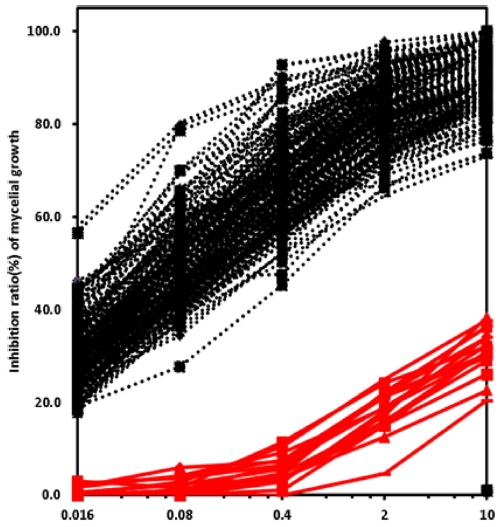
Inhibitory effect of pyraclostrobin on the mycelial growth of Colletotrichum acutatum on potato dextrose agar medium without 100 μg/mL of salicylhydroxamic acid (SHAM). Pyraclostrobin was amended into PDA by the indicated concentrations. C. acutatum was incubated at 25oC, of which the diameter was investigated 10 days after inoculation. Black line indicated isolates sensitive to pyraclostrobin, while red line did isolates resistant to the fungicide.
살균제에 대하여 뚜렷한 저항성 반응을 보이는 균주들은 모두 2015년도에 채집한 균주였고, 2004년부터 2014년에 채집한 균주들의 평균 EC50값은 모두 0.2 μg/mL 이하였다. 각 연도별 병원균 집단의 저항성 요인을 비교하여 보아도 2004년부터 2014년까지는 3.5부터 157.0까지 분포하였지만, 2015년도에 채집한 균주들의 저항성 요인은 40,000 이상으로 매우 높았다(Table 2). 2015년에 채집한 저항성 균주들의 채집한 장소는 충청남도 청양, 부여, 공주 그리고 전라북도 익산으로 지리적으로 매우 인접한 곳에 위치하고 있었다.
Strobilurin계 살균제에 대한 저항성 발현은 Alternaria, Blumeria, Didymella, Podospaera, Pyricularia, Venturia 등과 같이 많은 식물병원진균에서 보고되어 있다(Ma and Michailides, 2005). 하지만 고추 탄저병을 일으키는 C. acutatum에서는 본 연구에서 처음 보고하는 바이다. Table 2에서 보는 바와 같이 2014년까지 국내의 고추 재배 주산지를 중심으로 채집한 C. acutatum 균주에서는 pyraclostrobin에 대한 저항성 균주를 확인하지 못하였지만, 2015년 충남의 일부 지역인 청양, 부여, 공주에서 채집한 병원균들이 저항성을 보이기 시작하였다. 2014년까지의 병원균 집단에서 저항성균이 발견되지는 않았지만, 포장에서 병 방제를 위해서 사용되기 시작한 후, 시간이 경과하면서 채집한 연도별 병원균 집단의 평균 EC50 값은 서서히 증가하고 있는 것을 알 수 있었다(Table 2).
Strobilurin계 살균제는 식물병원진균에 활성을 보이는 천연물질을 기반으로 합성하여 개발된 살균제이기는 하지만, 그 작용점이 매우 특이적이기 때문에 저항성 문제가 쉽게 발생한다. 저항성 발현을 억제하고 살균제의 효과를 계속 유지하기 위해서는 정확하고 엄격한 포장 사용 기준과 더불어 처리 체계를 만드는 것이 중요하다(Vawdrey and Grice, 2005). 1997년 코스타리카에서 바나나 Sigatoka병을 방제하기 위해서 strobilurin계 살균제를 사용하기 시작하면서 FRCA(Fungicide Resistance Action Committee)은 사용 기준으로 1) 연간 최대 사용횟수는 8회, 2) strobilurin계 살균제의 2회 연속 사용 금지, 3) 추천 농도와 약량 준수, 4) 발생이 심한 지역에서는 처리 간격을 14-16일 이상 유지 등을 추천하였다. 2000년 8월 병원균의 살균제에 대한 감수성이 저하되면서 사용 기준을 변경해서 연간 최대 4회까지 사용, 저항성 병원균 발생 지역에서는 사용 금지 등을 변경과 추가하였으며, 2007년에는 연간 사용 횟수를 3회로 감소, 단제 사용 금지 등 더 엄격한 사용 기준을 제시하였다(Amil et al., 2007). 미시간주립대학의 자료에 따르면 pyraclostrobin의 사용을 잿빛곰팡이병 방제를 위해서는 연간 3회, 기타 병의 방제에도 4-5회로 제한하고 있다(Michigan State Univerfsity, 2010). 하지만 국내에는 strobilurin계 살균제에 대한 사용기준이 제대로 마련되어 있지 않는데, 이미 일부 지역에서 저항성 병원균이 발생한 상태이기 때문에, strobilurin계 살균제 사용에 대한 엄격한 기준 마련이 필요한 상황이다.
Fig. 1은 한천희석법을 사용하여 strobilurin계 살균제의 균사생장 억제효과를 조사한 결과이다. 배지 상에서 strobilurin계 살균제의 효과를 검정하는 경우, 사용하는 병원균의 종류 또는 조사하는 방법 등에 따라서 효과가 많이 달라질 수 있다. 이는 cyt bc1 복합체의 활성이 strobilurin계 살균제에 의해서 억제된다고 하더라도 대체호흡 경로를 통해서 전자가 이동되고 결국 ATP가 합성되기 때문이다(Vanlerberghe and Mcintosh, 1997; Joseph-Horne and Hollomon, 2000). 이러한 대체호흡 경로는 Magnaporthe grisea, Septoria tritici, Botrytis cinerea, Venturia inaequalis 등에서 알려져 있다(Tamura et al., 1999; Ziogas et al., 1999; Zheng et al., 2000; Kim et al., 2003). Botrytis cinerea에 대한 azoxystrobin의 포자발아 억제효과를 조사할 경우, 살균제를 처리하고 6시간 동안 배양할 경우에는 포자발아 억제효과가 지속되지만, 배양시간이 12시간이 지나면서 병원균의 포자발아 억제가 회복된다(Inoue et al., 2012). 하지만 대체호흡 과정을 억제하는 SHAM을 혼합처리 할 경우 포자발아 억제는 24시간이 지나도록 지속된다. Phytophthora catorum의 경우 azoxystrobin과 SHAM을 같이 첨가가 배지 상에서 균사생장 억제효과가 azoxystrobin 단독으로 처리하였을 때보다 크게 증가하는 반면에, 유주포자에 대한 발아 억제효과는 azoxystrobin 단독 처리와 azoxystrobin과 SHAM의 혼합 처리 간에 거의 차이가 없었다(Rebollar-Alviter et al., 2007). 본 실험에서도 한천희석법을 사용하여 C. acutatum에 대한 pyraclostrobin 저항성 발현을 모니터링할 때 대체호흡억제제인 SHAM의 처리 유무가 pyraclostrobin의 균사생장 억제효과에 영향을 미치는 지를 조사하였다. Fig. 2에서 보는 것과 같이 pyraclostrobin에 대해서 감수성인 3균주 C. acutatum 15BY4, 15GJ4, 15JD1, 그리고 저항성인 3 균주 C. acutatum 15YG1, 15GJ1, 15IS3를 선발하여 병원균에 대한 pyraclostrobin의 균사생장 억제효과를 조사하면서, 대체호흡 억제제인 SHAM을 첨가하여 pyraclostrobin의 효과가 변화하는지의 여부를 조사하였다. 하지만 SHAM을 pyraclostrobin과 같이 첨가한다고 해서 살균제의 균사생장 억제효과가 상승하지는 않았다. 또한 Fig. 2의 6균주만이 아니라 실험에 사용한 227개 모든 균주를 pyraclostrobin에 대한 저항성과 감수성으로 구분하여 SHAM을 처리한 경우와 처리하지 않은 경우의 EC50값을 비교하였다(Table 3). Jin et al.(2009)은 C. capsici, Botrytis cinerea, Rhizoctonia solani, Magnaporthe grisea에 대한 azoxystrobin의 균사생장 억제효과를 조사하면서 SHAM의 첨가효과를 SHAM 요인값으로 비교하였는데, 요인값은 첨가하지 않았을 때 각 병원균의 EC50값을 첨가하였을 때의 EC50값으로 나누어 계산하였다. C. capsici와 B. cinerea의 SHAM 요인값은 40.40과 215.73으로 SHAM을 처리하였을 때 azoxystrobin의 효과가 상승하였다. R. solani와 M. grisea는 1.33과 1.86으로 SHAM 첨가가 살균제의 균사생장 억제효과에는 아무런 영향을 미치지 않았는데, C. acutatum의 요인값도 0.37로, SHAM의 첨가가 pyraclostrobin의 균사생장 억제효과에는 영향을 미치지 않았다. 따라서 배지 상에서 고추탄저병균의 strobilurin계 살균제에 대한 균사생장 억제효과를 조사할 경우 대체호흡 억제제를 첨가할 필요는 없었다.
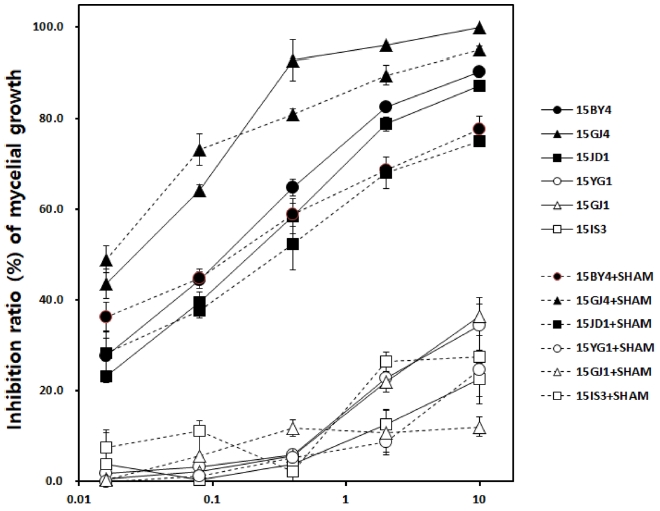
Inhibitionary ratio (%) of pyraclostrobin against the mycelial growth of Colletotrichum acutatum causing pepper anthracnose on PDA with (dotted line) or without (solid line) 100 μg/mL of salicylhydroxamic acid (SHAM). For assessing inhibition effect of pyraclostrobin on C. acutatum, 6 isolates of C. acutatum, which consist of 3 susceptible isolates(15BY4, 15GJ4 and 15JD1) and 3 resistant ones (15YG1, 15GJ1 and 15IS3), were used in this experiment.
고추탄저병균의 cyt b 유전자 분석
Pyraclostrobin에 대하여 저항성과 감수성 균주들을 선발하여, gDNA를 추출한 후, 미토콘드리아의 cyt b 유전자를 증폭한 결과, 저항성균과 감수성균 모두에서 617 bp의 산물이 증폭되었다(Fig. 3). 증폭된 cyt b 유전자의 염기서열을 분석한 결과, 저항성인 17개 균주들은 모두 143번째 아미노산 코돈이 GCT (alanine)이었지만, 감수성인 균주들의 143번째 아미노산 코돈은 모두 GGT (glycine)로 확인되었다(Fig. 4). Strobilurin계 살균제는 cyt b 유전자에서 점돌연변이, 대체호흡, 독성물질의 세포외 방출 등이 저항성 기작으로 알려져 있는데(Fernandez-Ortuno et al., 2008), 가장 많은 식물병원균에서 저항성이 나타나는 기작은 cyt b 유전자에서 점돌연변이이다. 병원균의 cyt b 유전자에서 strobilurin계 살균제에 대한 저항성과 관련된 점돌연변이는 여러 종류가 보고되어 있는데 143번째의 아미노산이 glycine에서 alanine으로 치환되는 돌연변이(G143A)가 가장 많이 알려져 있다. 이미 Erysiphae graminis f. sp. tritici, E. graminis f. sp. hordei, Mycosphaerella fijiensis, Sphaerotheca fuliginea, Pyricularia grisea, Didymella bryoniae, Venturia inaequalis, Cercospora beticola 등에서 G143A이 병원균의 살균제 저항성 원인이 되고 있다(Sierotzki et al., 2000a; Sierotzki et al., 2000b; Zheng et al., 2000; Kim et al., 2003; Sedlak et al., 2013). 뿐만 아니라 Pythium aphanidermatum과 같이 129번째 아미노산이 phenylalanine에서 leucin으로 치환되는 점돌연변이(F129L)에 의해서 저항성이 발생하기도 한다(Bartlett et al., 2002).
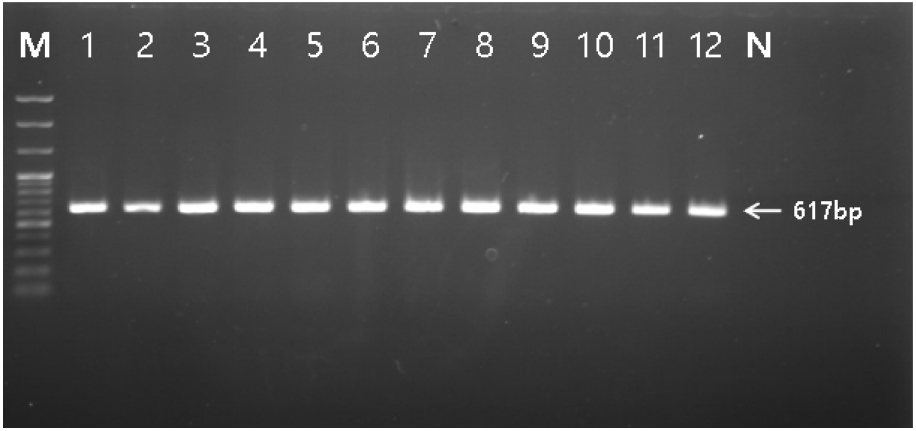
PCR product of amplified cyt b gene through agarose gel electrophoresis. DNA of Colletotrichum acutatum extracted from the mycelia incubated on PDA at 25oC for 10 days was used as a template. cyt b gene was amplified by using the primer pair of CacytP2 (forward) and CacytR (reverse). M; 100 bp marker, 1; 15BY1, 2; 15CY1, 3; 15IS1, 4; 15GJ1, 5; 15CY10, 6; 15IS4, 7; 15GC1, 8; 15BY4, 9; 15GP1, 10; 15GJ4, 11; 15MA1, 12; 15AS34 and N; negative control.
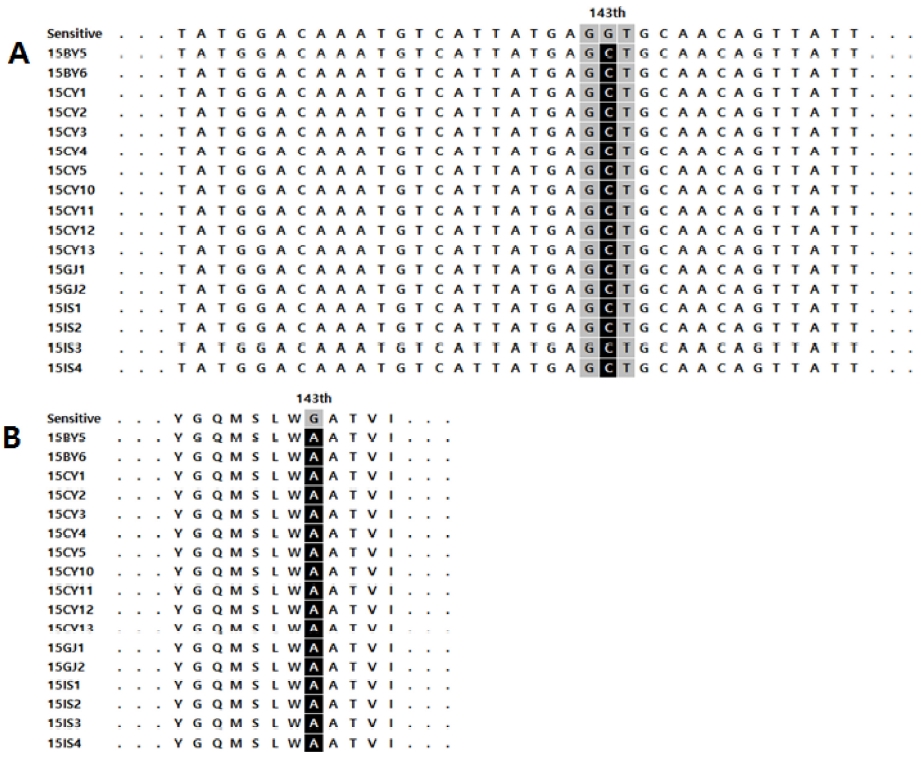
Nucleotides (A) and amino acid (B) sequence of amplified cyt b gene, obtained with DNA of Colletotrichum acutatum. The black box was indicated as a point mutation from glycine (GGT) to alanine (GCT).
그런데 본 연구에서 사용한 C. acutatum은 저항성인 17균주 모두가 G143A 돌연변이에 의해서 저항성이 발현되었다. 추후에도 계속적인 모니터링을 통해서 G143A 돌연변이에 의한 저항성균의 여부를 조사해야할 뿐만 아니라 새로운 위치에서의 돌연변이가 나타나는 지의 여부도 조사해야 할 것으로 생각한다.
돌연변이를 이용한 Allele-specific PCR
전국 고추 포장에서 분리한 고추 탄저병균들 중 2015년도에 분리한 17 균주들이 pyraclostrobin에 대하여 저항성 반응을 보였고, cyt b 유전자를 분석을 해본 결과 143번째 아미노산이 glycine에서 alanine으로 치환이 일어나 있었다. 이러한 DNA 염기서열 상의 점돌연변이를 이용하여 pyraclostrobin에 대하여 저항성 균주와 감수성 균주를 구별할 수 있는 allele-specific primer를 제작하고, allele-specific PCR 방법을 확립하였다. Forward primer는 CacytF를 공동으로 사용하였고, reverse primer는 저항성 균주 검출은 R-mmc, 감수성 균주 검출은 S-mmc를 제작하여 PCR에 사용하였다. 그 결과 CacytF/R-mmc를 사용한 PCR에서는 pyraclostrobin 저항성 균주에서만 78 bp의 증폭산물을 확인하였으며, CacytF/S-mmc를 사용한 PCR에서는 pyraclostrobin 감수성 균주에서만 78 bp의 증폭산물을 확인할 수 있었다(Fig. 5).
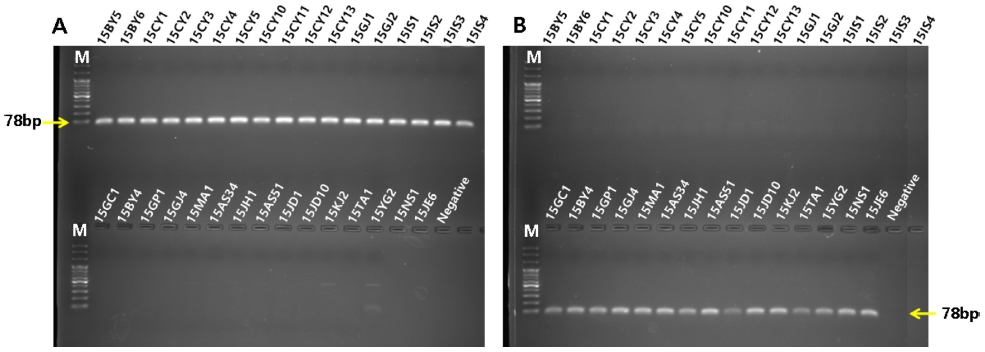
Allele-specific PCR for the detection of Colletotrichum acutatum isolates resistant (A) or sensitive (B) to pyraclostrobin. The mutation site that G143A in cyt b gene was used for design of allele-specific primer (A; PCR was using primers CacytF/R-mmc, B; PCR was using primers CacytF/S-mmc). M; 100 bp ladder.
Allele-specific PCR 방법의 민감도를 확인하기 위해서 pyraclostrobin 저항성 균주인 15CY3과 감수성 균주 15NS1의 DNA 농도를 100 ng부터 1 pg까지 10−1배씩 희석한 DNA를 사용하여, CacytF/R-mmc와 CacytF/S-mmc를 가지고 allele-specific PCR을 수행하였다. 그 결과 100 ng부터 0.1 ng까지는 증폭산물을 확인할 수 있었지만, 이 이하의 DNA 농도에서는 증폭산물이 확인되지 않았다(Fig. 6).
Acknowledgments
본 연구는 농촌진흥청 공동연구사업(과제번호: PJ0108212019)의 지원에 의하여 수행되었습니다.
References
-
Amil, A. F., S. P. Heaney, C. Stanger and M. W. Shaw (2007) Dynamics of QoI sensitivity in Mycosphaerella fijiensis in Costa Rica during 2000 to 2003. Phytopathology 97(11):1451-1457.
[https://doi.org/10.1094/PHYTO-97-11-1451]

-
Baumler, S., F. G. Felsenstein and G. Schwarz (2003) CAPS and DHPLC analysis of a single nucleotide polymorphism in the cyt b gene conferring resistance to strobilurin in field isolates of Blumeria graminis f. sp. hordei. J. Phytopathol. 151(3):149-152.
[https://doi.org/10.1046/j.1439-0434.2003.00699.x]

-
Bartlett, D. W., J. M. Clough, J. R. Godwin, A. A. Hall, M. Hamer and B. Parr-Dobrzanski (2002) The strobilurin fungicides. Pest Manag. Sci. 58(7):649-662.
[https://doi.org/10.1002/ps.520]

- Collina, M., L. Landi, P. Guerrini, M. B. Branzanti and A. Brunelli (2005) QoI resistance of Plasmopara viticola in Italy: biological and quantitative real-time PCR approaches, in Modern Fungicides and Antifungal Compounds IV, ed. by H. W. Dehne, U. Gisi, K. H. Kuck, P. E. Russell and H. Lyr. BCPC, Alton, Hants, UK, pp.81-88.
- Fernández-Ortuño, D., J. A. Torés, A. de Vicente and A. Pérez-García (2008) Mechanisms of resistance to QoI fungicides in phytopathogenic fungi. Int. Microbiol. 11:1-9.
- Heaney, S. P., A. A. Hall, S. A. Davies and G. Olaya (2000) Resistance to fungicide in the QoI-STAR cross-resistance group: current perspective, in: Proceeding of the British Crop Protection Conference: Pest and Disease 2000, Franham, Surrey, UK, British Crop Protection Council, pp.755-762.
-
Inoue, K., T. Tsurumi, H. Ishii, P. Park and K. Ikeda (2012) Cytological evaluation of the effect of azoxystrobin and alternative oxidase inhibitorsin Botrytis cinerea. FEMS Microbiol. Lett. 326(1):83-90.
[https://doi.org/10.1111/j.1574-6968.2011.02438.x]

-
Ishii, H., B. A. Fraaije, T. Sugiyama, K. Noguchi, K. Nishimura, T. Takeda, T. Amano and D. W. Hollomon (2001) Occurrence and molecular characterization of strobilurin resistance in cucumber powdery mildew and downy mildew. Phytopathology 91(12):1166-1171.
[https://doi.org/10.1094/PHYTO.2001.91.12.1166]

-
Jin, L., Y. Chen, C. Chen, J. Wang and M. Zhou (2009) Activity of azoxystrobin and SHAM to four phytopathogens. Agri. Sci. China 8(7):835-842.
[https://doi.org/10.1016/S1671-2927(08)60285-0]

-
Joseph-Horne, T. and D. W. Hollomon (2000) Functional diversity within the mitochondrial electron transport chain of plant pathogenic fungi. Pest. Manag. Sci. 56(1):24-30.
[https://doi.org/10.1002/(SICI)1526-4998(200001)56:1<24::AID-PS71>3.0.CO;2-Y]

-
Kang, B. K., J. Y. Min, Y. S. Kim, S. W. Park, N. van Bach and H. T. Kim (2005) Semi-selective medium for monitoring Colletotrichum acutatum causing pepper anthracnose in the field. Res. Plant Dis. 11(1):21-27.
[https://doi.org/10.5423/RPD.2005.11.1.021]

-
Kim, J.-Y., S.-S. Hong, J.-W. Lim, K.-Y. Park and H.-G. Kim (2008) Screening of fungicide resistance of cucumber powdery mildew pathogen, Sphaerotheca fusca in Gyeonggi Province. Res. Plant Dis. 14(2):95-101.
[https://doi.org/10.5423/RPD.2008.14.2.095]

-
Kim, Y. S., E. W. Dixon, P. Vincelli and M. L. Farman (2003) Field resistance to strobilurin (QoI) fungicides in Pyricularia grisea caused by mutations in the mitochondrial cyt b gene. Phytopathology 93(7):891-900.
[https://doi.org/10.1094/PHYTO.2003.93.7.891]

-
Ma, Z., D. Felts and T. J. Michailides (2003) Resistance to azoxystrobin in Alternaria isolates from pistachio in California. Pestic. Biochem. Physiol. 77(2):66-74.
[https://doi.org/10.1016/j.pestbp.2003.08.002]

- Michigan State Univerfsity (2010) Use strobilurin fungicides wisely to avoid fungicide resistance development. https://www.canr.msu.edu/news/use_strobilurin_fungicides_wisely_to_avoid_fungicide_resistance_development, . Accessed 4 May 2010.
-
Oo, M. M. and S-K. Oh (2016) Chilli anthracnose (Colletotrichum spp.) disease and its management approach. Kor. J. Agri. Sci. 43(2):153-162.
[https://doi.org/10.7744/kjoas.20160018]

-
Piszczek, J., K. Pieczul and A. Kiniec (2018) First report of G143A strobilurin resistance in Cercospora beticola in sugar beet (Beta vulgaris) in Poland. J Plant Dis Prot 125(1):99-101.
[https://doi.org/10.1007/s41348-017-0119-3]

-
Rebollar-Alviter, A., L. V. Madden, S. N. Jeffers and M. A. Ellis (2007) Baseline and differential sensitivity to two QoI fungicides among isolates of Phytophthora cactorum that cause leather rot and crown rot on strawberry. Plant Dis. 91(12):1625-1637.
[https://doi.org/10.1094/PDIS-91-12-1625]

-
Saxena, A., R. Raghuwanshi, V. K. Gupta and H. B. Singh (2016) Chilli Anthracnose: epidemiology and management. Front. Microbiol. 7:1-18.
[https://doi.org/10.3389/fmicb.2016.01527]

-
Sedlák, P., R. Vávra, P. Vejl, S. Boček and J. Kloutvorová (2013) Efficacy loss of strobilurins used in protection against apple scab in Czech orchards. Hort. Sci. 40(2):45-51.
[https://doi.org/10.17221/22/2013-HORTSCI]

-
Sierotzki H., S. Parisi, U. Steinfeld, I. Tenzer, S. Poirey and U. Gisi (2000) Mode of resistance to respiration inhibitors at the cyt bc1 complex of Mycosphaerella fijiensis. Pest Manag. Sci. 56(10):833-841.
[https://doi.org/10.1002/1526-4998(200010)56:10<833::AID-PS200>3.0.CO;2-Q]

-
Sierotzki H., J. Wullschleger and U, Gisi (2000) Point mutation in cyt b gene conferring resistance to strobilurin fungicides in Erysiphe graminis f. sp. tritici field isolates. Pestic. Biochem. Physiol. 68(2):107-112.
[https://doi.org/10.1006/pest.2000.2506]

-
Steinfeld, U., H. Sierotzki, S. Parisi, S. Poirey and U. Gisi (2001) Sensitivity of mitochondrial respiration to different inhibitors in Venturia inaequalis. Pest. Manag. Sci. 57(9):787-796.
[https://doi.org/10.1002/ps.356]

-
Tamura, H., A. Mizutani, H. Yokioka, N. Miki, K. Ohba and M. Masuko (1999) Effect of the methoxyiminoacetamide fungicide, SSF129, on respiratory activity in Botrytis cinerea. Pesticide Sci. 55(7):681-686.
[https://doi.org/10.1002/(SICI)1096-9063(199907)55:7<681::AID-PS16>3.0.CO;2-8]

-
Vanlerberghe, G. C. and L. Mcintosh (1997) Alternative oxidase: from gene to function. Ann. Rev. Pl. Mol. Biol. 48(1):703-734.
[https://doi.org/10.1146/annurev.arplant.48.1.703]

- Vawdrey, L. L. and K. Grice (2005) Field evaluation of strobilurins, triazoles and acibenzolar to control Sigatoka disease in Australia. InfoMusa 14:11-15.
-
Zheng, D., G. Olaya and W. Köller (2000) Characterization of laboratory mutants of Venturia inaequalis resistant to the strobilurin-related fungicide kresoxime-methyl. Cur. Genetic. 38:(3)148-155.
[https://doi.org/10.1007/s002940000147]

-
Ziogas, B. N., B. C. Baldwin and J. E. Young (1999) Alternatice respiration: a biochemical mechanism of resistance to azoxystrobin (ICIA5504) in Septoria tritici. Pesticide Sci. 50(1):28-34.
[https://doi.org/10.1002/(SICI)1096-9063(199705)50:1<28::AID-PS555>3.3.CO;2-T]


